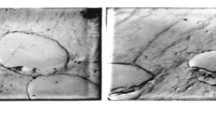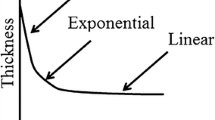Abstract
The effect of various weaving types for fabric composites on the low-speed (up to 350 m/s) penetration into multilayer fabric barriers made of aramid fibers is studied. The geometric properties of plain and twill weaves are taken into account on the basis of experimental data showing that the warp and weft threads may have different elastic and ultimate properties. Significant differences in the parameters of interlayer friction are also taken into account for the fabrics of various weave patterns. The results of full-scale experiments for the penetration into four-layer and ten-layer fabric barriers are used to verify the models of penetration into fabric barriers and to study the penetration into composite fabrics with various mutual arrangements of plain and 3/3 twill weaves. It is shown that some particular laying methods based on layer alternations can improve the protective properties of multilayer fabric barriers.
Similar content being viewed by others
References
K. M. Kirkwood, J. E. Kirkwood, Y. S. Lee, et al., “Yarn Pull-out as a Mechanism for Dissipating Ballistic Impact Energy in Kevlar KM-2 Fabric,” Text. Res. J. 74, 920–928 (2004).
P. A. Mossakovsky, V. V. Balandin, A. P. Belyaev, et al., “Investigation of Dissipative Factors in Puncturing Multilayered Woven Obstacles,” Probl. Prochnosti Plastichnosti 77 (4), 385–392 (2015).
A. P. Belyaev, “Experimental and Numerical Study of the Effect of Weaving Types, the Impactor Shape, and the Transverse Weave on the Penetration into Multilayer Fabric Barriers,” in Transactions of Young Scientists (Mosk. Gos. Univ., Moscow, 2016), pp. 71–78.
A. P. Belyaev, “Experimental and Numerical Study of the Interlayer Friction Parameters in Fabric Composites on the Basis of Reduced Models,” in Transactions of Young Scientists (Mosk. Gos. Univ., Moscow, 2017), pp. 62–69.
M. A. Martinez, C. Navarro, R. Cortes, and J. Rodriguez, “Friction and Wear Behaviour of Kevlar Fabrics,” J. Mater. Sci., No. 28, 1305–1311 (1993).
A. P. Belyaev, T. A. Belyakova, Yu. P. Zezin, et al., “Development and Verification of Reduced Mathematical Models for the Dynamic Loading of Composite Fabrics,” in Lomonosov Readings (Mosk. Gos. Univ., Moscow, 2017), p. 31.
Author information
Authors and Affiliations
Corresponding author
Additional information
Russian Text © A.P. Belyaev, 2019, published in Vestnik Moskovskogo Universiteta, Matematika. Mekhanika, 2019, Vol. 74, No. 1, pp. 61–64.
About this article
Cite this article
Belyaev, A.P. Effect of a Laying Method for Various Weaving Types on the Protective Properties of Multilayer Fabric Barriers. Moscow Univ. Mech. Bull. 74, 20–23 (2019). https://doi.org/10.3103/S0027133019010047
Received:
Accepted:
Published:
Issue Date:
DOI: https://doi.org/10.3103/S0027133019010047




